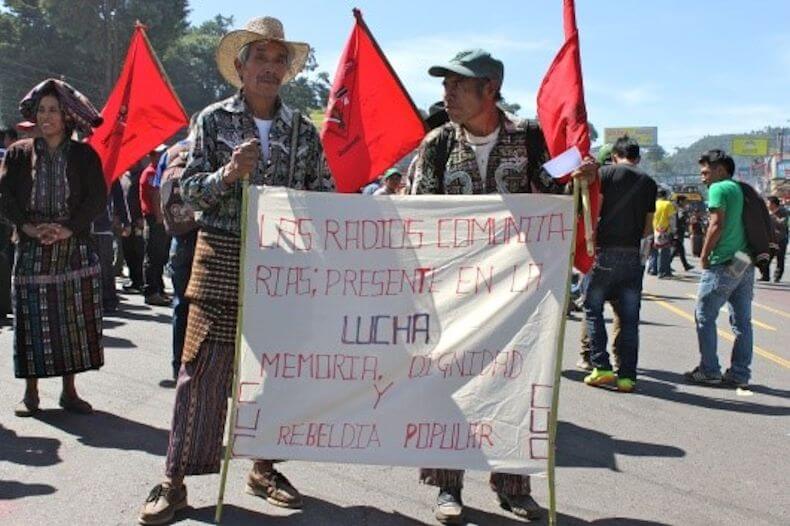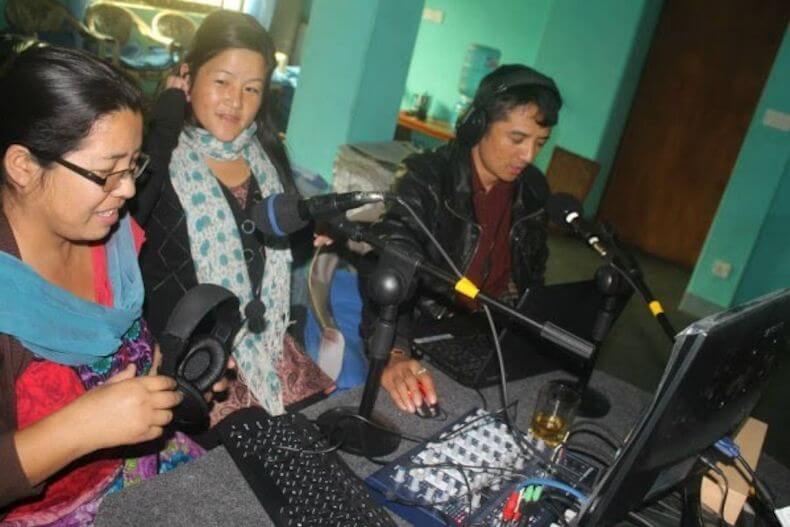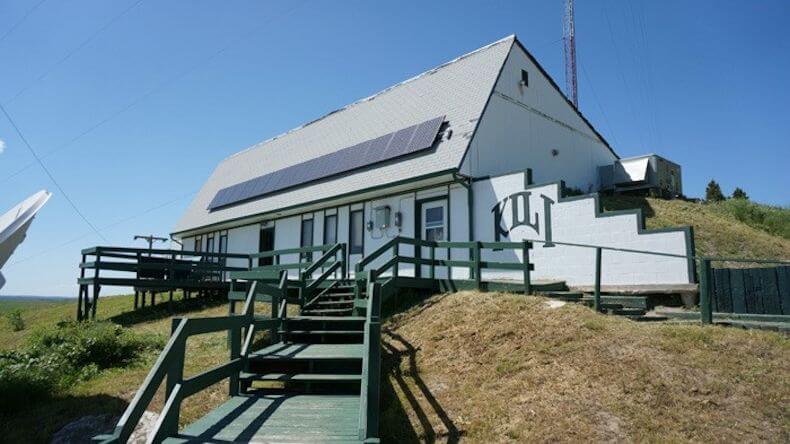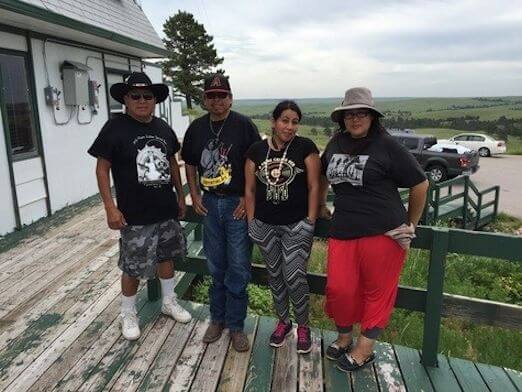
In 1941, famous folk musician and activist, Woody Guthrie famously stylized his guitar with the slogan: “This Machine Kills Fascists“. Some short years later, community radio – another machine where music and activism would intersect to serve justice – entered stage left and began its journey towards empowering communities at the micro and macro level, in virtually every corner of the globe. To this day each community-powered station that emerges creates a new, local nexus of power, which in turn serves as a platform for the community to occupy its rightful place amongst broader democratic, economic, and social movements.
Community radio is uniquely situated to cater to the needs of Indigenous communities. The opportunity to produce community-generated mass media can be channeled to support Indigenous language revitalization and preservation efforts. It also provides an easily accessible channel to disseminate culturally appropriate information on public health, development, and politics in real time. The simple and resilient medium is pragmatic and cost-effective on the receiving end, as well as (moderately) cheap on the broadcasting side. It has the potential to organize community members dispersed over difficult terrain be it urban or rural, as well as the power to reach areas that lack phone or internet services.
Members of the Bribri tribe in Amubri, Costa Rica access can their community radio station to create Indigenous language public service announcements like weather bulletins and educational information. These special broadcasts reach community members living in remote areas, where some people still prefer to speak only Bribri. ‘La Voz De Talamanca’ (‘The Voice of Talamanca’) also broadcasts educational programming on such issues as environmental protection and cultural health. Like most Indigenous radio stations, La Voz de Talamanca has an interdependent relationship with the community it serves; one of the ways the community reciprocates is by organizing fundraising activities to keep the station on the air.
Indigenous community radio is a worldwide phenomenon, but like the Bribri, its roots are firmly planted in Indigenous Latin America. In the late 1940s, community radio stations began springing up in Bolivia and Colombia as a collective reaction to systemic issues of poverty and injustice. The famous (or ‘infamous’ depending on who you ask) Miners’ Radio in Bolivia began broadcasting a show called, ‘La Voz del Minero ‘ (‘Voice of the Miner’) in the Department of Potosi around this time. This station was founded by the Federación Sindical de Trabajadores Mineros de Bolivia (FSTMB), a powerful political force of the working class that still influences Bolivian politics today. The FSTMB notably joined with other Aymara and Quechua groups in organizing the protests against water privatization in 2000, and collaborated again a few years later to campaign for the nationalization of Bolivian natural gas reserves—President Evo Morales delivered on the latter in 2006.
The Indigenous roots of Bolivia’s mining culture run deep. The reverence that Indigenous Peoples hold for oral tradition and participatory democracy was no doubt a factor of the miners’ embrace of the community radio platform. Most of the Bolivian proletarian class at that time had grown up speaking Quechua or Aymara; and many that sought work in the mines retained close ties to their Indigenous-speaking communities. The lexicon of Bolivia’s mining culture contains Indigenous-English hybridized terms, and many of the original Miner’s Radio broadcasts were in Quechua and Aymara.
Despite its economic pragmatism and accessible technology, community radio’s potential is often stymied by sociopolitical constraints and institutionalized structures of oppression by state and private interests. The historical narrative of oppression surrounding Bolivian Miners’ Radio is similar in many ways to dynamics in present day Guatemala. In Guatemala, even though Indigenous communities were guaranteed the right to broadcast in the 1996 Peace Accords, Indigenous community radio stations are to this day routinely and violently oppressed by government and private security forces. Comparably, in late 1940s Bolivia, even after the Tin Barons were displaced, the corrupt government still viewed the Indigenous and campesino community radio mobilization with suspicion. Stations operated under the constant threat of destruction at the hands of military forces. And in the end, it was indeed the collective efforts of the miner-organized strikes that brought down the dictatorship in Bolivia in 1981.
Beyond such a central role in organizing for workers’ rights, and eventually revolution, the original community radio stations in Bolivia also served as cultural and educational venues. The medium provided a space for surrounding communities to voice their opinions and express their given and cultivated talents. Unfortunately, most community radio stations of this era were displaced under the neoliberal government agenda of the mid 1980’s, and a relatively small percentage of modern day community radio stations are actual legacies of the original Miners’ Radio stations. At present, there are estimated to be around 2,000 community radio stations operating in Bolivia.
Fortunately, the official attitude to community radio in Bolivia today has evolved in leaps and bounds. This is due in no small part to Indigenous Aymaran president, Evo Morales (who is also a former coca growers’ union leader). Morales has successfully promoted community radio as an alternative to the mainstream media; and in June of this year, Bolivia hosted the first International Conference on Community Radio and Free Software. Thanks to ongoing broadcasts in Quechua, Aymara, and Guaraní, community radio stations in Bolivia have the ability to reach communities and villages that other media services and technologies simply do not.
Despite the medium’s deep history in popular or people’s struggles, support for community radio is certainly not some dog whistle expressing support for leftist or anti-imperialist causes. It is practical governance. In 2011, President Barack Obama signed the Local Community Radio Act in the United States after it finally passed through Congress in late 2010. Making a point of the medium’s broad-spectrum political appeal, the framework for the bill was based on a previous version that, in 2007, was sponsored but failed to pass by none other than Obama’s 2008 Republican challenger John McCain. Included in the canon of virtues touted by advocacy groups, was the opportunity it affords Indigenous groups in the U.S. to broadcast in their native languages. The bill found more favor after research had definitively shown that allowing local community groups to access low power airwaves did not actually interfere with commercial radio activity, as had been feared. This unsubstantiated fear has also been cited as a motivation behind the violent crackdowns on Indigenous community radio stations in Guatemala.

Two protesters at last year’s International Indigenous People’s Day, holding a sign that reads: “Community Radios: present in the fight for memory, dignity and popular rebellion (Photo: Cultural Survival)
Resiliency and economic pragmatism play a role in making Indigenous community radio a popular medium in Guatemala. And as previously noted, their right to access the airwaves was guaranteed in the famous Peace Accords of 1996. The Indigenous Peoples of Guatemala had suffered immensely during the previous 36 years of civil war, which was host to Rios Montt’s ‘Scorched Earth Campaign’- a systematic and violent oppression of genocidal proportions inflicted against Guatemala’s Indigenous Peoples. The accords ushered in a new era of ostensible peace, but despite promises, the airwaves were soon auctioned off to much higher bidders, resulting in further oligarchic concentration of control over media outlets. Since no pathways towards community radio licensure are currently codified in Guatemalan law, there is effectively an ‘illegal loophole’ that is being used to oppress Indigenous organizations that are exercising their right to broadcast – a right guaranteed to them some 20 years prior.
Reporters Without Borders issued a release a few months back citing concerns about the ongoing violent oppression of community media outlets in Guatemala. One of the latest incidents to raise international attention was when the mayor of Santa Eulalia oversaw violent intimidation tactics designed to forcibly prevent Radio Snuq Jolom Konob from reopening in March of this year. Prensa Comunitaria reporter Lucía Ixchíu, in a statement to Reporters Without Borders, said that they not only threatened and insulted community members and reporters but also resorted to actual physical violence.It is well accepted that such violent intimidation tactics are in response to the station’s recent coverage of Indigenous mobilizations against the construction of the Hidro Santa Cruz hydro-electric dam. Communities have protested and voiced concerns over the ecological and cultural impact it would have on the area that is currently home to Indigenous groups such as the Akateko, the Chui, the Popti’ and the Q’anjob’al.
At any rate, a broad in scope cost-benefit analysis might lead the Guatemalan government to embrace community radio on practical terms. In fact, to avoid a harsh and abrupt education in disaster management and public health somewhere down the line, they could just look to Nepal. Earlier this year when the devastating 7.8 magnitude earthquake shook Nepal to its core, community radio was able to fill the vacuum created by the exceeded limitations and exhausted capabilities of more sophisticated technologies. In certain regions lacking internet service or newspaper delivery, it was the only source of information available to disaster relief and recovery efforts. Less than 50% of Nepalis are deemed ‘literate’ in vernacular language, yet almost everyone – around 90% – owns a radio.
Myriad sources were tapped to sustain these vital lifelines, post-quake. The Nepali government provided power to keep local community radio station, Radio Sindhu, afloat, while Radio Melamchi was able to continue broadcasting through the use of solar technology. Radio Gorkha operated in a UNESCO-sponsored tent after their office was badly damaged.

Photo: Dev Kumar, Indigenous Media Foundation
There are around 350 community radio stations currently operating in 74 districts of Nepal, which collectively comprise the Association of Community Radio Broadcasters (ACORAB). Ganesh Kumar Jimee, Program Manager of Disaster Preparedness and Response at the National Society for Earthquake Technology-Nepal (NSET), warned in 2012 that:
The role of radio becomes crucial because during an earthquake, people want information first more than anything, and they look to the radio as the best means of communication.
Post-quake, the programming on Nepal’s community radio stations consisted mostly of what has been termed “lifeline” programs. These broadcasts provided support for recovery efforts, as well as emotional and psychological support for people coping with post-earthquake devastation and trauma.
Community radio has a relatively short history in Nepal, which works to highlight its relevance in modernity. In 1997, the emergence of Radio Sagarmatha marked the transition of control over the airwaves from the government to the people – a valiant step forward in the creation of a pluralistic democracy.
In the wake of this shift, community radio stations have played a central role in various Indigenous Nepali identity movements, like that of the Athpahariya, a dense and isolated group occupying the hills of east Nepal. Their local community radio station, Radio Makalu, has been an important venue that enables them to aggregate and assert their traditional identity on a public forum. This is especially crucial to the Athpahariya because their identity is currently not included on census records, nor are they counted among Nepal’s 59 officially recognized Indigenous nationalities.
These sorts of official exclusions are sometimes referred to as ‘paper genocide’, and are symptomatic of larger patterns of oppressive bureaucratic colonialism. Community radio can thus play a positive role in the dismantling of this antiquated colonial apparatus while constructively replacing it with a more progressive atmosphere of legal pluralism and plurinationalism that better reflect the Indigenous experience.
The Danuwar Indigenous group experienced a similar collective identity crisis when they found themselves geographically divided, sparsely distributed among 62 of the 75 districts that make up Nepal. On their path to reclaiming their Indigenous identity, the Danuwar have embraced their Indigenous language and utilized it to create broadcasts on Radio Namobuddha. The impacts of this sort of investment in their community are manifold. While serving the more immediate needs of dispensing valuable and culturally appropriate information, they are simultaneously advancing their long term goals of identity and empowerment (i.e. sovereignty and self-governance).
UNESCO defines community radio as one that is operated “in the community; for the community; about the community; and by the community.” And further claims that, “Community radio catalyzes the development efforts of rural folk and the underprivileged segments of urban societies, given its exceptional ability to share timely and relevant information on development issues, opportunities, experiences, life skills and public interests.”
As previously explored, it is by no means a partisan issue. In an increasingly disaster prone world, this resilient technology is needed more than ever as vital infrastructure to maintain order and promote recovery efforts post-disaster. In more stable times, it is especially effective in assuring that each community has equal access to information, a keystone of both democracy and public health.
Community radio has the potential to evolve as a manifestation of the collective human right to freedom of expression. It offers each community a place to participate in broad discourse with every other level of political, social and economic influence. For it to function properly, it is crucial that ownership and freedom be guaranteed and defended at the community level; and it would serve well if such access was codified into law at any given opportunities. This is especially important for Indigenous communities that are often – if not always – extremely marginalized by surrounding political and economic forces.
In order to achieve its peak potential in service to humankind, Indigenous community radio must be afforded the respect from surrounding interests to function as a true representation of the community it serves. This is the only way to guarantee that it will functionally serve the community, while thus enabling the community to serve its larger role in civil and municipal matters at the regional, national and international levels. Afforded its full potential, it can also facilitate progressive shifts towards a healthy state of plurinationalism—a system of governance and jurisprudence that Bolivia adopted at the constitutional level in 2009 – that recognize Indigenous autonomy as foundational to effective governance.

Photo: KILI website.
KILI 90.1, the self-described ‘Voice of the Lakota Nation’, broadcasts from the famous Pine Ridge reservation in South Dakota. KILI is owned and operated by the Lakota community. Along with culturally relevant music and news, KILI provides their 30,000 + listener base with health information, updates on council meeting activity, and serves the overall goal “to preserve Native American culture and instill pride in the peoples’ unique heritage”. On Wednesday evenings, there is also a Lakota Storytelling hour that is broadcast in the traditional Lakota language.
IC Magazine caught up with Lloyd Bianis, Sr., long-time volunteer community DJ at KILI. Lloyd began the discussion by relaying how passionate he was about serving their populations of veterans. He emphasized this focus several times and expressed his devotion to do whatever he could to support their vets through his work at the radio station. According to Lloyd, whose tastes and playlists tend to lean toward the classic country he grew up listening to with his parents, the station plays the music that the community wants to hear on the three reservations it serves: Pine Ridge, Rosebud, and Cheyenne River; as well as the people tuning in from Rapid City, the southern Black Hills, and on KILI’s internet stream. Along with the tribal council meetings, KILI also broadcasts local sports matches and will be broadcasting the first part of a pow-wow coming up in August 2015.
One of the benefits of serving their community is that the community serves KILI right back. After recalling a story on how community members had pitched in to buy them a new transmitter, Lloyd also spoke of listeners (both on and off the reservation) coming together recently to provide them with a new air conditioner. The new air conditioner arrived at a time when the extreme heat was threatening to put them off the air.
Lloyd remains amazed at how quickly supporters of the station can rally together to provide for KILI’s needs, and marveled at how their community had also provided them with Mac computers to use for station activities. (Readers who would like to take a moment to support the current and future needs of this valuable community resource for the Lakota people can do so by visiting their webpage).
KILI broadcasts 24 hours a day, 7 days a week – Lloyd is there every day. And when a volunteer dj is not behind the controls, an automated computer system that the station community has dubbed, ‘Seymore’, fills in for any gaps in programming. Along with their internet streaming services, KILI is also active on Facebook and Twitter.
Lloyd confirmed that Indigenous community radio seems to be trending, and cited a few cases of new Native American stations hitting the airwaves in several states. The National Museum of the American Indian has catalogued a (non-exhaustive) list of Native American community radio stations and their supporters. In 2013, estimates cited some 70 Native American stations in the U.S. (which actually represents just 10% of federally recognized tribes). The wave of new stations that Lloyd has witnessed is an impact of the policy shift in 2011 which opened up new frequencies for public use.

Photo: KILI website
Laura Medina, a representative from the Apache Stronghold – a convoy that just arrived in Washington DC to protest a land exchange bill – visited the KILI station recently for an interview. The bill in protest is for all intents and purposes a micro-level extractive industry land grab that was slipped into a defense bill by Arizona Senators John McCain and Jeff Flake. This is a rather typical move for extractive companies who often work in tandem with state officials to divest Indigenous groups of their right to, and their right to protect, the natural resources of their territory. It is similar in dynamics to the mining and development conflicts that Indigenous community radio stations are organizing against in Guatemala.
In addition to gaining the support of another Arizona Congressman, Raúl Grijalva, who introduced the bipartisan ‘Save Oak Flat Act’, the Apache Stronghold caravan has also teamed up with Neil Young.
To conclude with a final thought, there is a popular adage that says: ‘Give a man a fish and you feed him for a day; teach a man to fish and you feed him for a lifetime.’ Community radio has the potential to embody an even higher evolution of this philosophy- that at heart advocates for the value of autonomy and sovereignty. Adapted to context, the logic would follow as such: ‘If you respect a community’s right to access the airwaves, they can effectively organize themselves to solve their own problems, and then stand by your side as equals to address the larger problems of the world.’

Indigenous Peoples are putting their bodies on the line and it's our responsibility to make sure you know why. That takes time, expertise and resources - and we're up against a constant tide of misinformation and distorted coverage. By supporting IC you're empowering the kind of journalism we need, at the moment we need it most.